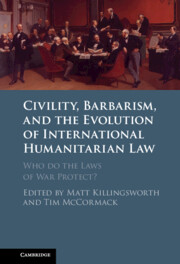 Civility, Barbarism and the Evolution of International Humanitarian Law
Civility, Barbarism and the Evolution of International Humanitarian Law Book contents
- Civility, Barbarism, and the Evolution of International Humanitarian Law
- Civility, Barbarism, and the Evolution of International Humanitarian Law
- Copyright page
- Contents
- Contributors
- Preface and Acknowledgements
- Abbreviations
- 1 Introduction
- 2 Sieges and the Laws of War in Europe’s Long Eighteenth Century
- 3 All’s Fair in Love and War or the Limits of the Limitations
- 4 Cultivating Humanitarianism
- 5 Limits to the Scope of Humanity as a Constraint on the Conduct of War
- 6 The State, Civility, and International Humanitarian Law
- 7 Operationalising Distinction in South Sudan
- 8 Private Military and Security Companies and International Humanitarian Law
- 9 Protecting Warfighters from Superfluous Injury and Unnecessary Suffering
- 10 Blurring the Lines
- 11 A Step Back to Take a Step Forward
- Index
- References
7 - Operationalising Distinction in South Sudan
Humanitarian Decision-Making about Military Asset Use*
Published online by Cambridge University Press: 11 January 2024
- Civility, Barbarism, and the Evolution of International Humanitarian Law
- Civility, Barbarism, and the Evolution of International Humanitarian Law
- Copyright page
- Contents
- Contributors
- Preface and Acknowledgements
- Abbreviations
- 1 Introduction
- 2 Sieges and the Laws of War in Europe’s Long Eighteenth Century
- 3 All’s Fair in Love and War or the Limits of the Limitations
- 4 Cultivating Humanitarianism
- 5 Limits to the Scope of Humanity as a Constraint on the Conduct of War
- 6 The State, Civility, and International Humanitarian Law
- 7 Operationalising Distinction in South Sudan
- 8 Private Military and Security Companies and International Humanitarian Law
- 9 Protecting Warfighters from Superfluous Injury and Unnecessary Suffering
- 10 Blurring the Lines
- 11 A Step Back to Take a Step Forward
- Index
- References
Summary
The principle of distinction in International Humanitarian Law sets up two entities, the civilian and the combatant, and organises the relationship between them. This socio-legal chapter draws on original research from South Sudan to explore how this principle is operationalised in humanitarian–peacekeeper interactions. Humanitarian actors routinely invoke ‘distinction’ as they navigate operational dilemmas with respect to the use of military assets, and in their relationship with the UN Mission in South Sudan more generally. Two ‘ideal types’ of humanitarian actor emerge here. The first type takes a strict approach to distinction, thinking long term and eschewing military asset use that undermines distinction. The second type interprets distinction flexibly and balances it with other goals such as reaching people in need; this exposes a hidden conflict between the principles of distinction and humanity. Through these everyday interactions – which sometimes involve drawing lines within the civilian category – humanitarian actors produce distinction in law, in practice, and in perception.
Keywords
- Type
- Chapter
- Information
- Civility, Barbarism and the Evolution of International Humanitarian LawWho do the Laws of War Protect?, pp. 135 - 155Publisher: Cambridge University PressPrint publication year: 2024
